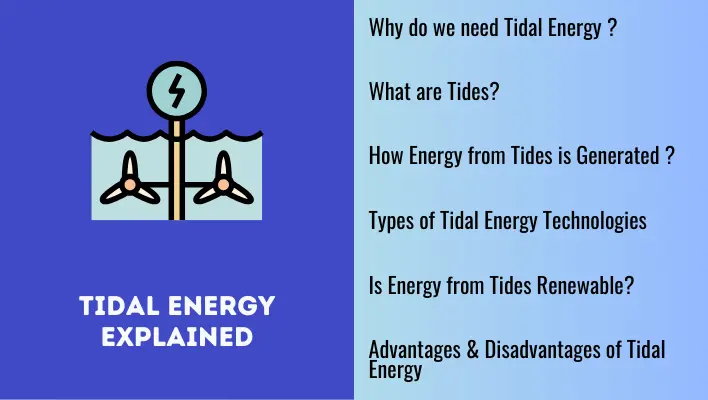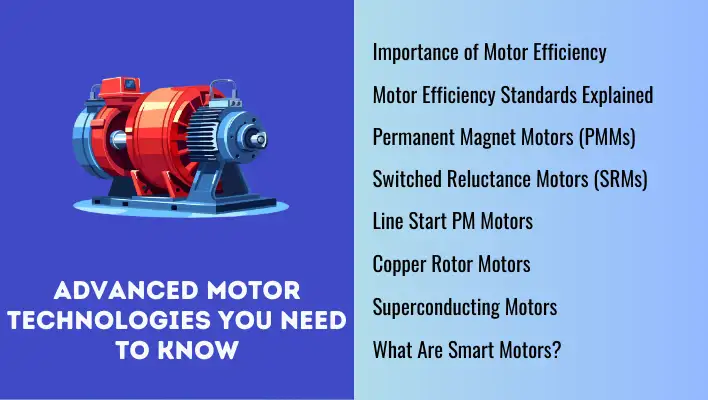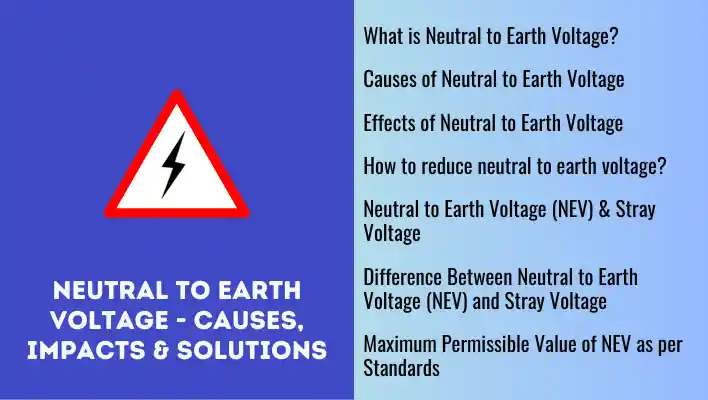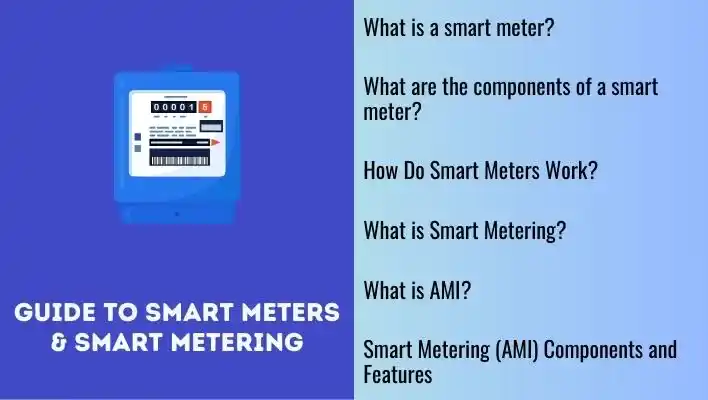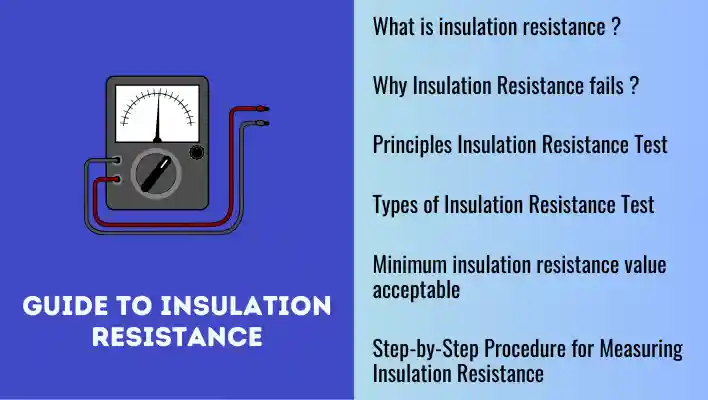Energy from tides known as Tidal energy is one of the many promising solutions for a fossil fuel free world. The tidal hydropower generated from oceans and seas is a cleaner and more sustainable source of energy. In this article, we’ll explore how energy from tides is generated and why it’s considered a renewable resource.
Solar Ponds | Everything You Need to Know
What are Tides ?

To understand how energy from tides can be harnessed, it’s important to first know what tides are and how they are formed.
Tides happen because of the gravitational pull of both the moon and the sun on Earth, but the moon plays a much bigger role since it’s closer. The moon’s gravitational force pulls the ocean waters, causing a regular pattern of rising and falling sea levels. This is what we call the tidal force.
As the moon pulls on the Earth’s oceans, it causes water to swell (bulge) in the areas closest to and farthest from the moon, which we experience as high tides. As the Earth rotates, this bulge moves, giving us the regular cycle of high and low tides.
There are two main types of tides: high and low tides.
High tides happen when the gravitational pull of the moon and the sun work together. This occurs when the Earth, moon, and sun are in a straight line, either during a full moon or a new moon. At these times, the gravitational forces combine, making the high tides even higher and the low tides even lower. These stronger tides are called Spring tides.
On the other hand, Low tides occur when the moon and sun form a right angle with the Earth. In this position, their gravitational pulls partially cancel each other out. This results in a smaller difference between high and low tides, with the tides being much weaker. Such weaker tides are called Neap tides. This happen during the quarter moon phases.
The predictability of tides makes them a reliable source of renewable energy. Since we can accurately forecast tidal patterns, their steady movement can be harnessed to generate tidal power efficiently.
What Is Green Hydrogen? Definition, Uses, Benefits & Types
How Energy from Tides is Generated
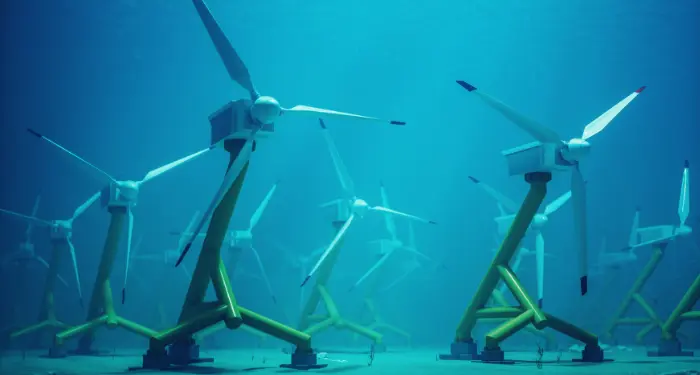
Energy from tides which is commonly known as Tidal energy, is a form of hydropower that uses the natural rise and fall of sea levels to generate electricity.
It works similarly to how hydroelectric dams use water flow to produce power. As the tides shift between high and low due to the moon’s gravitational pull, strong water currents are created. These currents turn turbines placed along the shoreline or underwater, converting the potential energy of the water into electricity.
When the tide comes in, the rising water is directed through turbines, producing energy. As the tide goes out, the receding water also passes through turbines, generating more power. This back-and-forth movement of water is the key to harnessing tidal energy.
Because tides are highly predictable and consistent, it makes a promising alternative to more variable sources like wind or solar.
Flywheel Energy Storage Explained
Types of Tidal Energy Technologies
There are several technologies used to harness tidal hydropower, each with its own approach to capturing energy from the tides:
Tidal Range
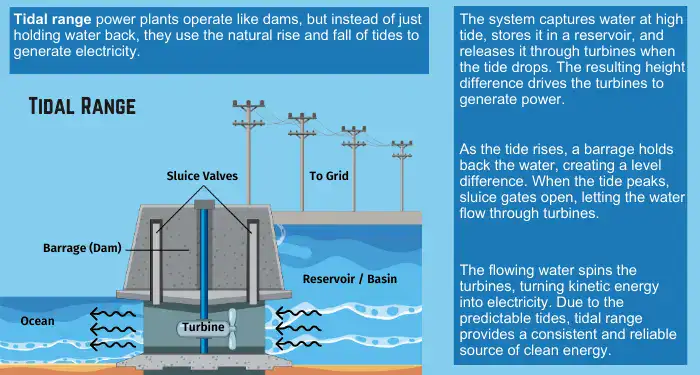
Tidal range power plants, a key technology for harnessing energy from tides. These plants operate like dams, but instead of just holding water back, they use the natural rise and fall of tides to generate electricity.
These plants are built in areas where the difference between high and low tide, known as the tidal range, is large enough to make the process efficient.
The system works by capturing water during high tide, holding it in a reservoir, and then releasing it through turbines when the water level outside drops, creating a height difference (called “head”). This head is what drives the turbines to generate power.
As the tide rises, the water is held back by a barrage (similar to a dam), creating a difference in water levels on either side of the structure. Once the outside water level reaches its peak, sluice gates are opened, allowing water to flow through the turbines.
The flowing water spins the turbines, converting the kinetic energy of the moving water into electricity. This process happens consistently due to the predictable nature of tides, making tidal barrages a reliable source of clean energy from tides.
There are three main types of tidal range systems:
- One-way power generation when sea level falls: Water is collected during high tide and released through turbines as the tide recedes. Power is generated for about four hours per day. An example is the Annapolis plant in Canada.
- One-way power generation when sea level rises: Water flows into the reservoir from the sea when the tide rises, generating electricity. However, this method produces less power and may have ecological downsides, as the water level in the reservoir remains low for extended periods. The Sihwa plant in South Korea uses this method.
- Two-way power generation: Both rise and fall of tides are used to produce energy, offering more hours of power generation per day. This system requires specialized turbines, like those used at La Rance in France, which can handle flow in both directions.
Tidal Stream
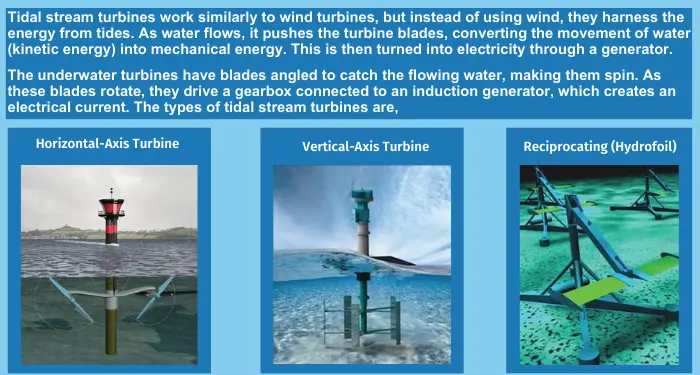
Tidal stream turbines work similarly to wind turbines, but instead of using wind, they harness the energy from tides.
As water flows, it pushes the turbine blades, converting the movement of water (kinetic energy) into mechanical energy. This is then turned into electricity through a generator.
Tidal stream generators take advantage of the natural flow of water caused by tides, much like wind turbines use air movement.
The underwater turbines have blades angled to catch the flowing water, making them spin. As these blades rotate, they drive a gearbox connected to an induction generator, which creates an electrical current.
Since tides move in and out, the turbines are designed to swivel 180 degrees to catch water moving in both directions. These turbines can be placed in coastal areas, such as harbors or lagoons, where water flow is strong and reliable.
There are two main types of tidal stream turbines:
- Horizontal-axis (axial) and vertical-axis (cross-flow) turbines: These turbines have blades either aligned with (horizontal) or perpendicular to (vertical) the water flow. They look like smaller versions of wind turbines but are designed to handle the denser, slower-moving water. This means the blades are smaller and turn more slowly but must endure stronger forces compared to wind turbines.
- Reciprocating devices: Instead of spinning blades, these turbines use hydrofoils, which are shaped like airplane wings. As water flows across them, the hydrofoils move up and down. This movement is then converted into rotational energy to drive a shaft or linked to pistons for hydraulic power generation.
Tidal Fence
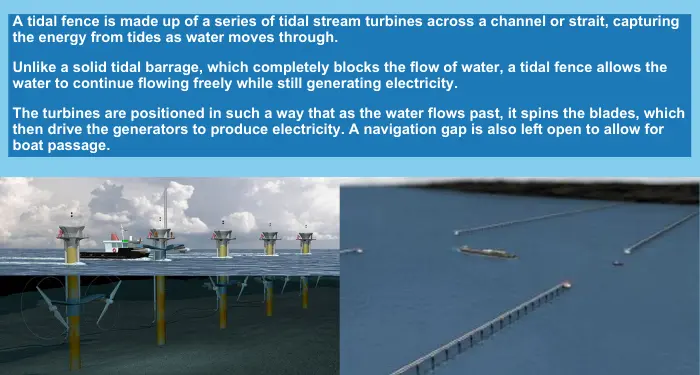
A tidal fence is made up of a series of tidal stream turbines across a channel or strait, capturing the energy from tides as water moves through.
Unlike a solid tidal barrage, which completely blocks the flow of water, a tidal fence allows the water to continue flowing freely while still generating electricity.
The turbines are positioned in such a way that as the water flows past, it spins the blades, which then drive the generators to produce electricity. A navigation gap is also left open to allow for boat passage.
Tidal fences offer some big advantages over tidal barrages. They have a smaller environmental impact because they don’t completely block the waterway, and they’re less disruptive to ships that need to navigate through the area.
They also require a lower upfront investment since they don’t need as much heavy construction. Additionally, tidal fences are more cost-effective than tidal stream arrays (which are collections of individual turbines) in areas with slower water flow, as they reduce infrastructure and maintenance expenses.
This combination of efficiency and lower environmental impact makes tidal fences a promising way to harness energy from tides.
Tidal Lagoon
Tidal lagoons are a type of tidal range technology that harnesses energy from tides by using a barrier or wall to capture the difference in water levels between high and low tides.
The concept is fairly simple: a wall or embankment is built to enclose a section of water, either in the sea or an estuary. As the tide comes in and out, the changing water levels drive turbines built into the wall, generating electricity from the movement of the water.
Although tidal lagoons hold a lot of potential for producing clean energy from tides, no operational lagoons exist yet. This is because there are still several challenges to overcome, including technological hurdles, financial costs, political considerations, and potential environmental impacts.
Despite these obstacles, the idea of using tidal lagoons remains promising, as they could provide a consistent and predictable source of renewable energy once these issues are addressed.
Energy Storage System | Key Technologies Explained
Why do we need Tidal Energy ?
Energy from tides is a renewable resource, much like solar and wind power, but with one key difference, it’s far more predictable. While the sun doesn’t always shine and the wind doesn’t always blow, tides follow a regular and reliable pattern.
We can forecast the rise and fall of tides and the speed of water flow years in advance with great accuracy. This reliability makes it easier to integrate tidal energy into the electrical grid, making it a dependable energy source compared to other renewables like wind or solar.
Another significant benefit of using energy from tides is its ability to reduce the use of fossil fuels, which contribute to climate change. Tidal energy doesn’t release harmful greenhouse gases or waste heat, making it an environmentally friendly choice.
There are many locations worldwide where strong tidal currents are already present. When these spots are near towns, cities, or large industries, harnessing tidal energy can be incredibly efficient. Instead of relying on electricity from faraway power plants, energy from tides can provide a local supply of power.
Moreover, using tidal energy can stimulate the local economy by creating jobs, especially during the construction and maintenance of tidal energy systems. It can also encourage the growth of industries that might benefit from a steady, nearby source of power.
By tapping into this predictable and renewable source, we not only help protect the environment but also support local communities with economic and social benefits.
Biomass Energy Explained | Resources, benefits & Tech
Is Energy from Tides Renewable?
Energy from tides is considered renewable because it is naturally replenished and doesn’t deplete the Earth’s resources.
Unlike fossil fuels, tidal power relies on the gravitational pull of the moon and sun, ensuring a consistent, ongoing energy source. As long as these celestial forces continue, tides will keep occurring, making tidal energy a reliable and sustainable option.
Environmental Benefits of Tidal Energy
Tidal energy is not only renewable but also environmentally friendly. It doesn’t produce harmful greenhouse gases or pollutants like traditional energy sources.
Additionally, tidal infrastructure, such as barrages and turbines, has a long lifespan, ensuring decades of clean energy with minimal upkeep. This makes it a valuable alternative to nonrenewable resources and a way to reduce our dependence on fossil fuels.
Guide to Geothermal Energy | How Earth’s Power is Harnessed?
The Debate: Is Tidal Energy Truly Renewable?
While tidal energy is widely accepted as renewable, some argue against this view. One notable example is a study by Stanford professor Jerry Z. Liu, who claims that using tidal energy could have severe consequences.
According to his research, tides are created by the Earth’s rotation and the gravitational pull of the moon and sun. Harnessing tidal energy taps into the Earth’s rotational energy, which could slow the planet’s spin over time.
Liu’s study suggests that if tidal energy met just 1% of global energy needs, it could significantly decelerate Earth’s rotation within 1,000 years, leading to catastrophic environmental changes.
Despite concerns like those raised by Professor Liu, most experts still view tidal energy as a clean, renewable, and reliable source of power.
The potential environmental impact, while worth considering, is far less immediate than the ongoing damage caused by fossil fuels. As the world searches for sustainable energy alternatives, tidal power remains a promising option.
Advantages of Tidal Energy
- Renewable: Energy from tides is a naturally occurring resource that comes from the gravitational pull of the moon and sun, combined with the Earth’s rotation. This means we can keep tapping into it for as long as the tides exist, making it a highly renewable source of power. Unlike fossil fuels or nuclear reserves, the forces behind tides are not going away anytime soon.
- Eco-Friendly: Not only is tidal energy renewable, but it’s also a green choice. It doesn’t take up large amounts of land and doesn’t produce harmful greenhouse gases, which helps in the fight against climate change.
- Predictable: One of the best things about energy from tides is its predictability. Unlike wind or solar power, which can be unpredictable, we know exactly when and how strong the tides will be. This allows engineers to design tidal systems that are well-suited to their environment, maximizing efficiency. Since the power of tides is so regular, it makes planning and integrating tidal energy into the grid much easier.
- Works at Low Speeds: Because water is about 1,000 times denser than air, tidal energy can be generated even at low speeds. Water flows moving at just 1 m/s can still produce significant amounts of electricity. This makes tidal energy highly efficient compared to wind power, where much faster speeds are required.
- Long-Lasting: Tidal power plants have a long operational life. For example, the La Rance tidal barrage in France, built in 1966, is still producing electricity today. This longevity means that while initial construction costs may be high, these plants provide a long-term, cost-effective source of power over their lifespan.
- Reduces Dependence on Imported Fuels: By producing electricity locally, tidal energy reduces the need to import foreign fuels, improving energy security.
- Protects Coastal Areas: The small dams and barrages used to generate tidal energy can also serve a dual purpose—protecting coastlines and ports from storm surges and harsh weather. This makes tidal plants valuable not only for their energy production but also for safeguarding communities from coastal erosion and extreme weather events.
Disadvantages of Tidal Energy
- Impact the Environment: Although energy from tides is eco-friendly in many ways, it’s not without potential environmental downsides. Tidal barrages, for example, can change ocean levels and impact marine ecosystems, much like hydroelectric dams. Fish migration can be disturbed, and turbine structures might interfere with marine animals’ natural movements.
- Not Constant: Tidal energy is intermittent since it depends on the natural cycles of tides, which only occur about 10 hours a day. This means it can’t produce electricity continuously. However, with the development of better energy storage systems, this issue can be mitigated to some extent, making tidal power a more reliable option.
- It Needs to Be Near the Shore: Tidal energy facilities need to be built near coastlines, and right now, most of the locations that can harness this energy are close to land. This limits where tidal plants can be installed.
- It’s Expensive to Build Tidal energy is still a relatively new technology, and building these systems comes with high upfront costs. Though it’s expected to become more commercially viable in the coming years, right now, it’s not the most cost-effective energy solution compared to other renewable sources like wind or solar. However, as technology improves and scales up, costs are likely to decrease.
- It’s Still in the Early Stages Tidal energy technology is still developing, with only a few operational plants around the world. Since it’s still in the research and prototype stage, tidal power hasn’t reached the scale needed to make it widely available. More investment, research, and technological breakthroughs are required to make tidal energy a mainstream power source.
- It Takes a Long Time to Build Building a tidal power plant can take years, or even decades, due to the complexity of construction and the high costs involved. Some projects, like the Severn Barrage in the UK, were cancelled due to time and cost overruns. Long construction times and delays can sometimes make these projects less appealing for investors and governments.
Tidal Energy FAQs
Where is tidal energy currently used?
Countries like the UK, France, Canada, and South Korea have developed tidal energy systems. The La Rance Tidal Power Station in France is one of the oldest and most successful tidal energy plants in the world.
Where does this energy come from?
The tides. As the tides rise and fall, they create strong currents. These currents can be harnessed to turn turbines and generate electricity. And because the tides are so predictable, we can count on this energy source to be there when we need it.
How does a tidal stream generator work?
A tidal stream generator works similarly to a wind turbine but is submerged underwater. As tidal currents flow through the blades of the turbine, the kinetic energy of the moving water is converted into rotational energy, which powers a generator to produce electricity.
What is the efficiency of tidal energy systems?
The efficiency of tidal energy systems can vary depending on the type and location, but tidal stream systems can reach an efficiency of around 80%, making them highly effective compared to other renewable energy technologies. Tidal barrages also have a relatively high efficiency, around 70-80%.
Can tidal energy be integrated with other renewable energy sources?
Yes, tidal energy can be integrated with other renewable energy sources, such as wind or solar power. This hybrid approach can provide more consistent energy output, balancing intermittent sources like wind and solar with the predictability of tides.
How does water density impact tidal energy production?
Water is about many times denser than air, which means that even slow-moving tidal currents can generate a significant amount of energy. This density allows tidal turbines to produce more power at slower speeds compared to wind turbines, making tidal energy highly efficient in the right locations.
What is the lifespan of a tidal energy system?
Tidal energy systems are known for their longevity. Tidal barrages can last over 100 years, while underwater turbines typically have a lifespan of around 25-30 years. With proper maintenance, these systems can provide a long-term source of renewable energy.

